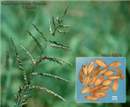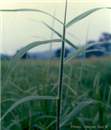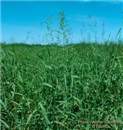Scientific name(s)
Brachiaria mutica
Urochloa mutica
Strengths
- Vigorous and productive.
- Palatable.
- Tolerant of heavy grazing.
- Tolerant of waterlogging and prolonged flooding.
Limitations
- Low seed production at low latitudes.
- Dormancy in fresh seed.
- Seed is expensive.
- Lower quality than other tropical grasses.
- Can be difficult to establish from seed.
Plant description
Plant: Coarse vigorous trailing perennial grass. Sward grows to a height of 1 m.
Stems: Stout stolons up to 5 m long, which branch and root readily at the nodes.
Leaves: Linear to lanceolate, tapering to an acute point. Leaves generally6 - 20 cm long and 1 - 2 cm wide. Leaves and leaf sheaths are generally hairy.
Seedhead: Inflorescences a panicle 6 - 30 cm long with 5 - 20 densely flowered racemes. Spikelets are elliptic, 2.5- 5 mm long, hairy, pale yellow when ripe.
Seeds: 3 mm long, approximately 935,000 seeds/kg.
Pasture type and use
It is mainly sown as a permanent pasture for grazing, in wet and flooded areas.
Where it grows
Rainfall
It is suitable for areas receiving 1000 mm/year or more. In the semi-arid tropics, it will only persist on seasonally flooded wetter areas where rainfall is 1300 mm or less.
Soils
It is tolerant of a wide range of soil types from acid infertile solodic soils to heavy cracking clay soils. It is tolerant of poor drainage and seasonal flooding to a depth of approximately 1 m. It survives prolonged flooding, but the bulk of growth is produced after the water recedes. Soils need to stay wet until June for it to persist.
Banks can be constructed to create ponds to store runoff water to grow para grass where rainfall is too low for it to persist.
Temperature
It is well adapted to tropical lowland environments.
Establishment
Companion species
Grasses: None. It is best sown as the only grass in a mixture.
Legumes: Is extremely competitive when established and will choke out legumes. Can be sown with Glenn, Lee, phasey bean, Bundey or Cavalcade as pioneer legumes. These legumes are not as tolerant of flooding as para grass and will not persist if flooded for more than 2 months.
Sowing/planting rates as single species
1 - 2 kg/ha. Have seed tested before sowing. Fresh seed can be dormant for up to 6 - 8 months after harvest.
Can be planted by cuttings or runners containing 2 - 3 nodes. Plant at 2 -4 m spacing, with at least one node being buried.
Sowing/planting rates in mixtures
1 - 2 kg/ha. The legumes will provide feed during the first year and an input of nitrogen, but generally will not be competitive with the grass after the second year, particularly where flooded.
Sowing time
Sow seed early to mid December to allow germination and growth before floods occur, as small seedlings can be killed by flooding. Sowing para grass by seed has generally not been successful.Plant cuttings into mud or shallow water (up to 15 cm deep) in January and February, depending on rainfall.As establishing para grass requires protection from excessive weed competition, a well prepared seedbed is an advantage.
Inoculation
Not applicable.
Fertiliser
On the more fertile clay soils, para grass pastures are generally not fertilised.
They require fertiliser, at least initially on less fertile soils such as the solodics. Responds strongly to nitrogen and phosphorus. Generally apply 100 - 250 kg/ha of superphosphate or its equivalent at establishment. Apply nitrogen at 25 - 50 kg/ha to grazed pastures. Applications of potassium, molybdenum, zinc or other deficient elements may be necessary on some soils.
Management
Maintenance fertliser
On infertile soils, generally apply 50 - 100 kg/ha of superphosphate or its equivalent. Apply nitrogen at 25 - 50 kg/ha to grazed pastures.
Grazing/cutting
It should be regarded as a browse grass. Grazing should be controlled to avoid excessive damage to runners.
The pasture can be lightly grazed during its first dry season. Once established it can tolerate heavy dry season grazing. Para grass pastures should be fenced off to prevent access by grazing animals during the wet season. This spells the pasture and allows it to regenerate each year.While it is tolerant of fire, and recovers after burning if the regrowth is not grazed, it should not be burnt. A hot fire can make para grass vulnerable to drought, overgrazing or flooding
Seed production
One line of para grass does not produce viable seed.
Seed production of the other line is limited. Expected seed yields are 10 -25 kg/ha. The main seed crop is harvested in May. Seed is set over a 4 week period, and mature seed is shed within days.
Ability to spread
Good. Plants are competitive once established, and will spread vegetatively into surrounding areas if there is little competition. It can spread 5 m in a year by runners on bare ground.
Weed potential
High. Evaluated with a high weed risk by the Northern Territory Weed Risk Assessment method. Adapted to wet and flooded areas.
Major pests
None recorded.
Major diseases
None recorded.
Herbicide susceptibility
Annual grasses can be controlled using low rates of Diuron.
Tolerant of selective herbicides used to control broadleaf weeds.
Animal production
Feeding value
It is of moderate to high quality compared to other tropical grasses. Crude protein (CP) of tops during the dry season is generally up to 3 - 10 %. The CP of the leaf, which is selected by grazing animals is generally 6 - 12 %, and up to 24 % in young regrowth at the beginning of the wet season. In vitro digestibility is generally up to 65 % during the growing season, dropping to 40 - 53 % during the dry season. In vitro digestibility in fresh regrowth can be up to 79 %.
Palatability
It is very palatable.
Production potential
Without applications of nitrogen fertiliser dry matter yields on infertile soils are generally 4 - 7 tonnes/ha. On clay soils or with the application of 100 - 200 kg/ha of nitrogen, yields are 10 - 15 tonnes/ha.
Livestock disorders/toxicity
No major problems reported in Australia.
Cultivars
| Cultivar | Seed source/Information |
| Local | Does not produce viable seed, planted by runners. |
| Seeded | Produces viable seed, available commercially. |
Further information
Web links:
Tropical Forages database (SoFT) - Para grass
Acknowledgements
-
Author and date
Arthur Cameron
June 2009





